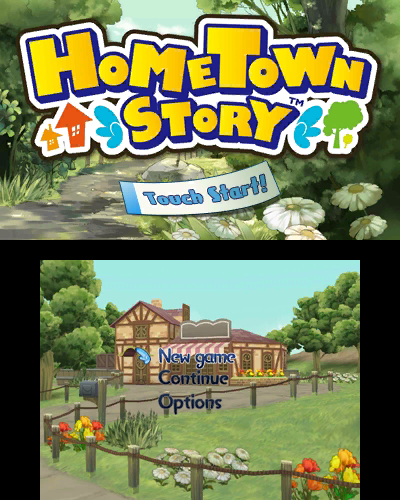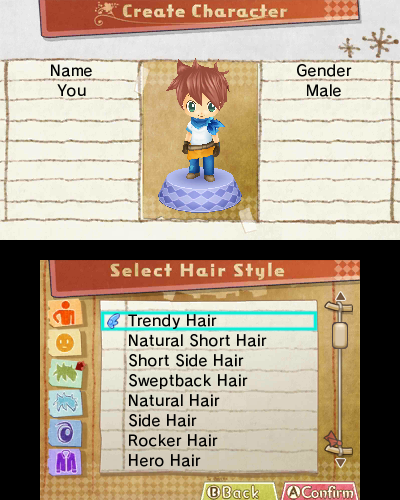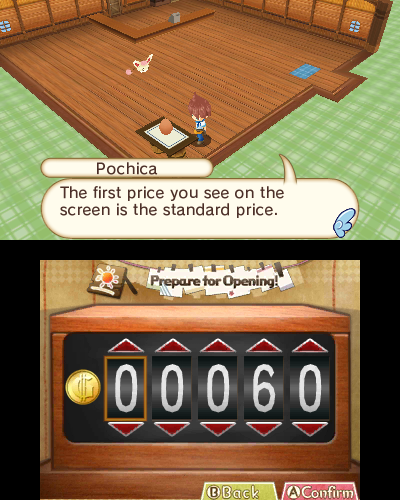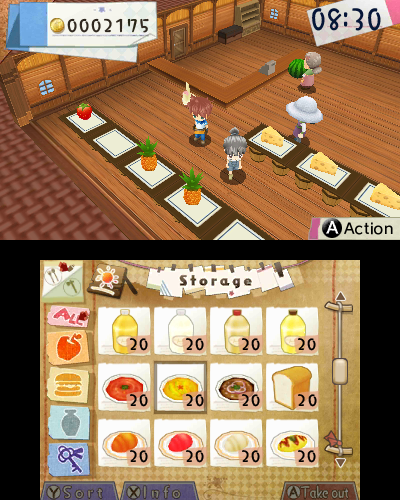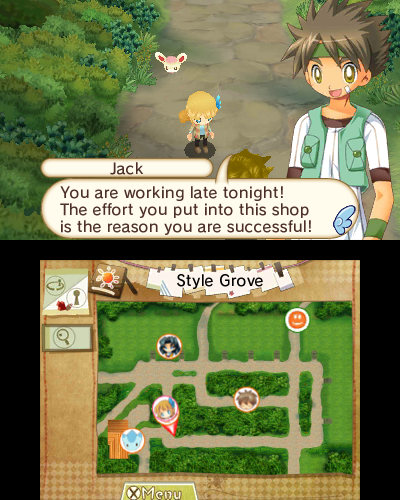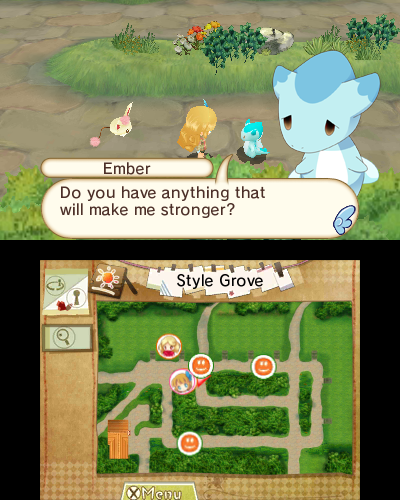Editor’s note: This is a re-post of a previously posted article that was lost due to our recent server difficulties.
Created by Harvest Moon creator Yasuhiro Wada, Hometown Story follows the adventures of a boy or girl (depending on your choice) who returns to their hometown to run a store they inherited from their grandmother. You’ll also meet the town’s inhabitants, make friends, and learn more about their lives, all while attempting to manage a fledgling store. If the basic premise sounds familiar to you (as in an awful lot like Harvest Moon, but with a store instead of a farm), well, you’d be forgiven for mistaking the two because they certainly are, for better or worse, similar.
At the game’s outset, you can choose your character’s name and gender, and there’s a healthy assortment of customization options (clothing, hair, etc.) to choose from to create the character you want. I crafted my dude with dark hair, blue eyes, and jeans so that he’d look like me. I guess I’m narcissistic like that, or something. You’ll also meet a sprite by the name of Pochica (the floating pink bunny-type creature) who acts as a guide and gives you advice.
Pochica then walks you through a short tutorial of how to set up and manage your store. You place tables throughout the building by touching your selection on the touchscreen, moving to where you want, and then hitting A. You can then set items for display by choosing said item and setting it on the table. It’s a simple process, and the touchscreen keeps it streamlined. I had my shop up and running in just a minute or two.
Villagers then came in, picked the item they wanted, and lined up in front of the cash register. Pushing A by the register confirms their purchase, and then they leave. However, you can only help one customer at a time, and they’ll line up at the register rather quickly. The demo didn’t include it, but a Natsume rep told me that if you aren’t quick enough, the customers will get angry and leave. I only had three or four customers at once, so it wasn’t too hectic, but there does seem to be a delicate balance between restocking shelves and helping your customers. Each character has certain products they like more than others, so knowing your customer base is important to maximizing your profits. You’ll also set the prices of your items. A suggested price appears on screen when you display the item, but you can change it to whatever you want. That said, the villagers won’t buy your wares if they’re too expensive.
Your store’s items don’t magically appear out of thin air, though, so you’ll have to venture out into town and the surrounding areas to look for things to sell. I encountered several merchants who sold a variety of food items and other wares. One merchant in particular had the ability to combine items into new items (like food ingredients into a sandwich, for instance) to sell for higher profit. The demo provided me with a vast assortment of items already, but creating new items to sell is as simple as having the necessary ingredients and picking the option to create it.
I passed by many of the town’s inhabitants as I wandered through town. A map on the touchscreen shows who’s passing through the area you’re currently in. Primary characters have a portrait, while other characters have a smiley. (These characters don’t have a story. I believe they are mostly around to shop.) Neither had anything too interesting to say, but since I was at the game’s beginning, I expected that, too. I also encountered several other sprites, which makes me wonder if they serve a greater purpose in the story, as well. The town begins with 10 inhabitants, but more move in as your shop grows larger and becomes more successful, meaning there’ll be more interactions and story as you play. That also means successfully selling your items will also grow more complicated as more people flood into your store. I’m not sure how many people can occupy it at once, though.
The demo didn’t feature any town events or let me fish, unfortunately, and some areas were blocked off. I did happen upon a mine of some sort but was unable to do anything there yet. The game uses an internal clock with one second equaling about one or two minutes of in-game time. No one seemed to shop at night, so planning for your store’s opening the next day (having the items you need, etc.) is important.
I found Hometown Story’s graphical simplicity charming. It’s colorful, but not extremely detailed. Its cutesy art style reminds me of a children’s pop-up book, and the 3D effect actually gives it a slight pop-up feel to it. A gentle folksy tune played while I ran around shopping and talking to people, too. Surprisingly, Nobuo Uematsu of Final Fantasy fame is Hometown Story’s composer, and I’d have to be six feet under to not be excited to see what he’s created for the game. While the character designs themselves are simplistic like the rest of the art in the game, the character portraits are well-detailed, bright, and pleasant to look at.
Natsume handed out a pamphlet at their booth that provided a few more details about Hometown Story. Each character is said to have their own unique story, and if that pans out, there could be a surprisingly deep narrative in Hometown Story. The game also has multiple endings, which is probably based, at least in part, on whom you marry.
Hometown Story is set to release at the end of this year. While its Harvest Moon-influenced gameplay is undeniable, the game has several features that set it apart from its brother. That said, if you aren’t a fan of Harvest Moon, Hometown Story might be a tough sell for you. The two are basically two sides of the same coin. For a game about spreading happiness and helping others, though, it’s surprisingly genuine, and yeah…I did find myself smiling uncontrollably, which is saying something, given my cynical nature.




